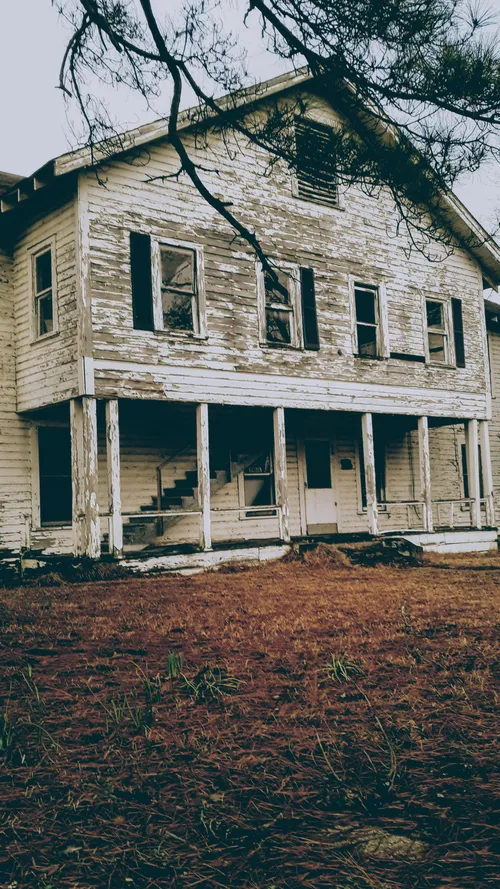The girl in the photo on her wall blinked.
Sarah froze, her coffee mug halfway to her lips, steam curling between her and the framed photograph. She stared at the image—a vintage black-and-white portrait she'd found at an estate sale during her first week in the house. The seller, an elderly woman with clouded eyes, had practically given it away.
"Just take it," the woman had said, pressing the frame into Sarah's hands. "She belongs with the house anyway."
Now, three months later, Sarah wondered if she'd imagined the movement. The girl in the photo—perhaps ten or eleven years old, with dark ringlets and a solemn expression—stared back with the same unblinking intensity as always. Sarah rubbed her eyes. Too many late nights unpacking, too much caffeine, too little sleep.
She'd bought the Victorian house on Elm Street for a fraction of its market value, despite the realtor's obvious reluctance to show it. The previous owners had fled after only six months, citing "bad vibes" and unexplained noises. Before them, a string of short-term residents had come and gone. The house had sat empty for two years before Sarah's offer was accepted with suspicious eagerness.
But Sarah needed a fresh start. After her divorce, after losing her job, after watching her carefully constructed life crumble, the house felt like salvation. Its bones were good—high ceilings, original hardwood floors, ornate moldings that spoke of craftsmanship from a bygone era. What did she care about superstitious former tenants?
The morning routine continued. Coffee, toast, a quick scan of her laptop for freelance opportunities. But her eyes kept drifting to the photograph. The girl's dress was white with tiny buttons, her hands folded primly in her lap. Something about her expression seemed different today—more urgent, more alive.
Sarah shook her head and carried her dishes to the kitchen. The house creaked around her, settling into the day's warmth. She was getting used to its sounds: the whisper of old pipes, the sighs of ancient floorboards, the occasional pop of expanding wood. Every old house had its symphony.
But lately, there had been other sounds. Scratching within the walls that couldn't quite be explained by mice. Soft footsteps in the hallway when she was certain she was alone. Whispers that might have been wind through loose window frames, if she could convince herself to believe it.
Her phone buzzed. A text from her contractor, Mike: "Can start the kitchen renovations Monday if you're ready. Fair warning—old houses like this, we might find some surprises in the walls."
Sarah smiled. She'd been saving for months to modernize the kitchen, and Mike came highly recommended despite his ominous warnings about "surprises." Every contractor seemed to have horror stories about mysterious wiring, crumbling plaster, or forgotten construction debris.
She spent the weekend clearing the kitchen, boxing up dishes and small appliances. The work felt therapeutic—purposeful in a way her life hadn't been for months. As she wrapped her grandmother's china, she hummed softly, feeling more optimistic than she had since moving in.
That night, she was awakened by the scratching again. This time it was directly above her bedroom, insistent and rhythmic. Sarah lay in the darkness, listening. The sound moved—not like an animal scurrying, but like something deliberate, following a path through the walls.
She grabbed a flashlight and crept upstairs to the attic access. The beam revealed nothing but dust motes dancing in stale air, old insulation, and the skeletal framework of the house. But the scratching had stopped the moment she'd opened the hatch, as if whatever was making the noise knew it was being hunted.
Monday morning arrived with the rumble of Mike's truck in the driveway. He was a bear of a man with kind eyes and calloused hands, the type who looked like he could rebuild your house from memory.
"Let's see what we're working with," he said, pulling on work gloves.
The demolition began with the removal of upper cabinets. Mike worked methodically, disconnecting electrical lines and carefully prying away decades of paint and caulk. Sarah watched from the doorway, fascinated by the archaeological layers being revealed—wallpaper from different eras, paint colors that told the story of changing tastes.
"Hold on," Mike said, pausing with his crowbar halfway through removing a section of drywall. "There's something here."
He pulled away more drywall, revealing a cavity that shouldn't exist—a space between the kitchen wall and what should have been the living room. His flashlight beam penetrated the darkness, and he went very still.
"Sarah," he said quietly. "You need to call the police."
"What? Why?" She moved closer, but Mike blocked her path.
"Trust me. Call them now."
But Sarah had already seen what made his voice shake. In the narrow beam of light, something white gleamed against the far wall of the hidden space. Fabric. And within the fabric, the unmistakable curve of small bones.
The police arrived within minutes—first the patrol cars, then the detectives, then the coroner. Sarah found herself sitting on her front porch, wrapped in a blanket despite the warm afternoon, watching her home become a crime scene.
Detective Martinez, a woman with sharp eyes and a gentle voice, sat beside her. "The medical examiner will need time, but preliminary assessment suggests multiple sets of remains. Children. This is going to take a while."
"How long have they been there?" Sarah's voice sounded distant to her own ears.
"Hard to say without proper examination. Could be decades."
The investigation consumed three days. Sarah stayed at a motel downtown, watching news crews gather outside her house like vultures. The story spread quickly: "House of Horrors Discovered," "Child Remains Found in Victorian Home," "Decades-Old Mystery Uncovered."
By Thursday afternoon, they'd found eleven sets of remains sealed within the walls. Ten complete skeletons, arranged with careful precision in small alcoves that had been bricked over and hidden behind false walls. The construction was expert—whoever had done it knew the house's structure intimately.
"There's something else," Detective Martinez told Sarah as they stood in what remained of her kitchen. "The eleventh set of remains... they're different."
"Different how?"
"Fresher. And incomplete."
They'd found evidence of long-term habitation in the spaces between walls—crude bedding made from scraps of fabric and insulation, collections of small bones from rats and birds, makeshift tools fashioned from debris. Someone had been living in the hidden passages for years, possibly decades.
"We found access points," Martinez explained. "Loose boards, hidden panels. Whoever was living in there could move throughout the house undetected."
The scratching sounds. The whispered voices. The feeling of being watched.
"Are they still here?" Sarah asked.
Martinez hesitated. "We're not sure. We found recent evidence of habitation, but no trace of whoever was living there. They may have fled when the demolition started."
That evening, Sarah returned to pack her things. The house felt different now—not haunted by ghosts, but by something far more real and infinitely more terrifying. She moved quickly through the rooms, throwing clothes into suitcases, wanting only to escape.
In the living room, she paused before the photograph of the girl. In the chaos of the investigation, it had been forgotten, still hanging on the wall where she'd placed it months ago. Now, looking at it, something clicked into place.
The girl's dress—white with tiny buttons. The same fabric they'd found with the first set of remains.
Sarah's hands shook as she lifted the frame from the wall. On the back, in faded ink, someone had written: "Emily Morrison, age 11, 1987."
Thirty-seven years ago.
A sound made her turn—a soft footstep in the hallway. Sarah's blood turned to ice. There, at the edge of the room, stood a figure that might once have been a child. Skeletal thin, draped in rags, with long matted hair hanging over a face that had forgotten how to be human. The creature's eyes were huge and dark, reflecting the lamplight like an animal's.
They stared at each other across the decades—the woman who had unknowingly shared her home with a nightmare, and the child who had survived by becoming something else entirely.
The creature's mouth opened, but no sound emerged. Sarah realized with horror that this was Emily Morrison, the girl from the photograph, aged by unimaginable trauma into something that could no longer speak, could no longer fully be called human.
"The police are looking for you," Sarah whispered.
Emily tilted her head, bird-like. Then she smiled—or attempted to. The expression was wrong, unused muscles moving incorrectly, creating something more disturbing than any scream.
She turned and melted back into the shadows, disappearing into passages that no blueprint had ever recorded. Sarah heard the faint sound of her movement within the walls, following familiar paths through the skeleton of the house.
The police would never find her. Emily Morrison had become part of the house itself, as much a fixture as the Victorian moldings and hardwood floors. She knew every secret passage, every hidden space, every way to remain invisible.
Sarah left that night and never returned. The house was condemned, then demolished six months later. But sometimes she wondered if Emily had simply found new walls to inhabit, new spaces to claim as her own.
The photograph went with Sarah to her new apartment across town. She told herself she kept it as a reminder, though she wasn't sure of what. Sometimes, late at night, she thought she saw the girl blink. But Sarah had learned not to look too closely at the things that moved in the corners of her vision.
Some survivors, she'd learned, become something else entirely. And some kinds of watching never really end.





This story has not been rated yet. Login to review this story.